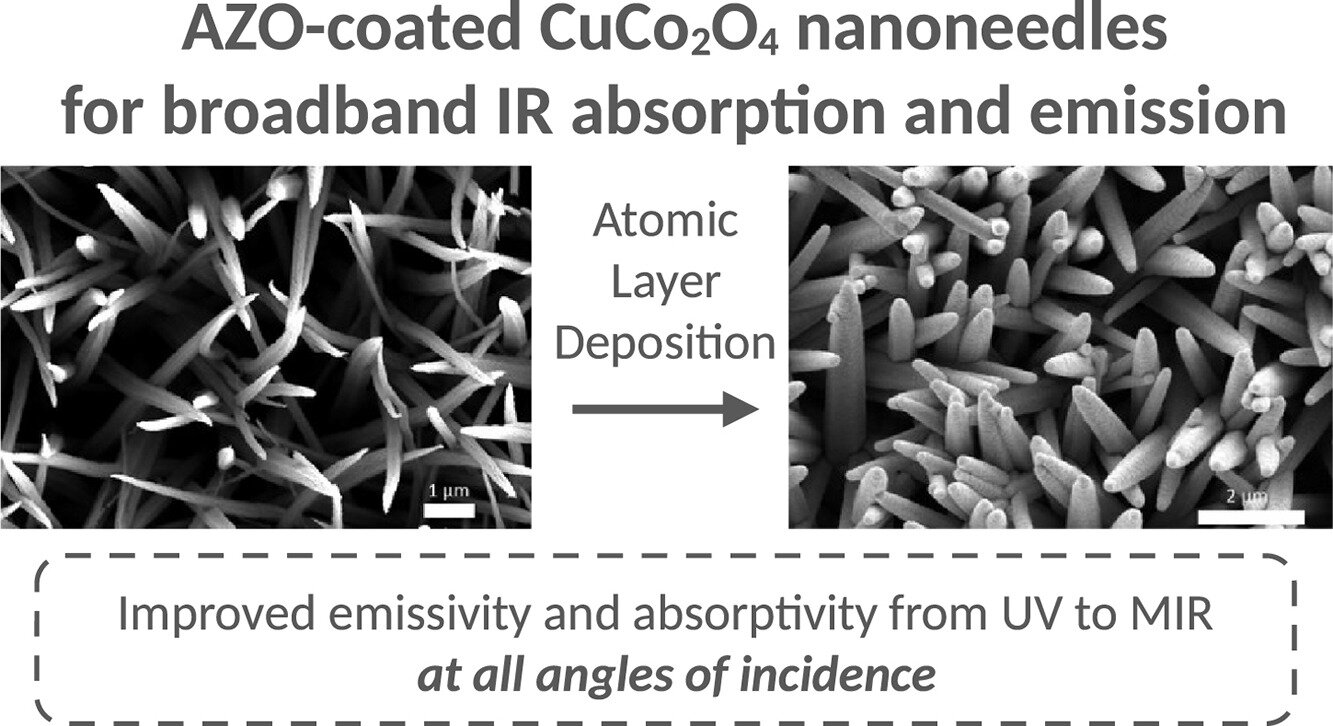
Using state-of-the-art equipment, researchers in the Thermophysical Properties of Materials group from the University of the Basque Country (EHU) have analyzed the capacity of ultra-black copper cobaltate nanoneedles to effectively absorb solar energy. They showed that the new nanoneedles have excellent thermal and optical properties and are particularly suited to absorbing energy. This will pave the way toward concentrated solar power in the field of renewable energies.
The tests were carried out in a specialized lab that has the capacity to undertake high temperature research. The results were published in the journal Solar Energy Materials and Solar Cells.
Renewable energy of the future is concentrated solar power because it can be easily used to store thermal energy. Despite the fact that, historically, it is more expensive and complex than photovoltaic power, in recent years huge advances have taken place in this technology, and concentrated solar power plants are spreading across more and more countries as a resource for a sustainable future.
As Iñigo González de Arrieta, a researcher in the Thermophysical Properties of Materials group, explained, “We are exploring ultra-black materials for use in solar towers.” In plants of this type, solar energy is directed by means of mirrors toward an energy-absorbing tower.
“The more we can achieve absorbing materials that are more effective, the more competitive the systems will be, and we will be opening up opportunities for this type of energy,” said Dr. González de Arrieta. Using state-of-the-art equipment created at the EHU lab itself, “we carry out thermo-optical analyses to measure the absorption properties of the samples that reach us. Internationally, there are few dedicated laboratories for conducting high-temperature research.”
The EHU researchers carried out the thermo-optical characterization of copper cobaltate nanoneedles patented by the University of California San Diego. “We saw that these copper cobaltate nanoneedles performed better than the carbon nanotubes used until now, and that these nanoneedles performed even better when coated with zinc oxide,” said Dr. González de Arrieta.
Aiming for 100% light absorption
Hundreds of mirrors positioned around solar towers concentrate solar rays onto a single point. The aim is to achieve maximum absorption on the tower; that is why the absorbing materials had to be ultra-black. The blackest materials currently available on the market comprise vertically aligned carbon nanotubes.
Even though these materials have suitable optical indices and highly suitable light-trapping geometries, “carbon nanotubes are not stable at high temperatures and in the presence of high humidity. So they need to be coated with more resistant materials and that reduces their optimization,” Dr. González de Arrieta explained. “Carbon nanotubes absorb about 99% of the light, but they cannot be used on solar towers.”
So he felt that copper cobaltate nanoneedles would mean a great step forward: “They are much more stable at high temperatures and, what is more, the nanoneedles coated with zinc oxide have greater absorption than the nanotubes used until now. The materials (black silicon) currently used on solar towers absorb 95% of the light and that is a lot; however, copper cobaltate nanoneedles absorb 99% of the light, and those coated with zinc oxide even more, 99.5%,” explained Dr. González de Arrieta.
Dr. Renkun Chen of the University of California San Diego is collaborating with the U.S. Department of Energy to start using copper cobaltate nanoneedles coated with doped zinc oxide on solar towers, “but we don’t know how that will end up, given the situation of uncertainty in the U.S.,” explained the researcher.
Solar tower plants are located in Andalusia and in some deserts across the world. In Spain, only 5% of the energy is provided by means of this technology. The researcher made it clear that “driving forward this renewable energy” is hugely important “because it offers many advantages: it is totally clean and can also be used when the sun isn’t shining.”
The sun’s heat absorbed on the towers is stored as thermal energy: “The sun’s heat is used, above all, to melt some specific salts. Melted salt retains heat very well, and then it is much easier to feed that thermal energy again into the power grid.”
Dr. González de Arrieta stressed the need to go on developing and characterizing new coatings with improved optical properties for use on solar towers. He added that in the future there might be a chance of continuing to explore the possibilities of coating the nanoneedles with materials that offer improved conductivity.
More information:
I. González de Arrieta et al, AZO-coated refractory nanoneedles as ultra-black wide-angle solar absorbers, Solar Energy Materials and Solar Cells (2025). DOI: 10.1016/j.solmat.2025.113840
University of the Basque Country
Citation:
Ultra-black nanoneedles absorb 99.5% of light for future solar towers (2025, October 29)
retrieved 29 October 2025
from https://techxplore.com/news/2025-10-ultra-black-nanoneedles-absorb-future.html
This document is subject to copyright. Apart from any fair dealing for the purpose of private study or research, no
part may be reproduced without the written permission. The content is provided for information purposes only.










